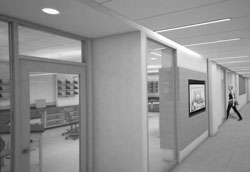When students walked through the doors of Edison Hall last year, they would find crowded tables crammed with students reading heavy textbooks and experiments being conducted in labs that looked only spacious enough for half the class. With such limited learning space for students, the science department set out to make changes that would transform students’ education.
The first part of a multi-phase renovation and expansion project is presently underway to make Edison Hall a state-of-the-art modern science building – one that will integrate research and teaching and allow all students, regardless of major, to engage in their own learning.
The renovation will progress in a series of modules, starting with the physics teaching laboratory and classroom areas on the East Side of the first floor of Edison Hall. The modules will host more spacious and welcoming teaching labs, research suites, faculty offices, and student study spaces poised adjacent to each other, encouraging interdisciplinary student and faculty collaboration in the process.
“The thing I love about this model,” remarked Dr. Michael Palladino, Dean of the School of Science, “is that it reflects the way the sciences are going. Research, teaching, student-faculty interaction, and student-student interaction all weave together. That’s the way you build a modern science building.”
Student-researchers will have 24-hour-access to the research suites, which will each combine two adjacent labs in related areas of research, essentially removing the wall in between and exploiting the space within to show off the building’s newly designed structure and excite students about the new educational possibilities. Although the labs would be combined, each research group would still have its own space.
“Even though I haven’t had a chance to actually see any of the progress yet, I am definitely excited about all the changes,” said Heather Siebert, senior chemistry major. “I love Edison how it is, but updates, in my opinion, are never a bad thing, especially if we get more research space. The only complaint I have is the noise of the construction which you can hear almost anywhere throughout the science building.”
Connected to the research labs will be study spaces, allowing students who were once crowded around a few round tables to have access to computer workstations with a more comfortable place to sit. Study spaces similar to the one recently constructed in the Edison lobby will be built directly into these modules and be located adjacent to faculty offices.
“I do not know what the reconstruction of Edison Hall will be like,” said Shivam Patel, senior biology major, “But I do know that establishing more accessible study areas for students will be well worth it. I can think of countless times when I have tried unsuccessfully to find a quiet place on campus to study. Being in the right environment, therefore, will provide a convenient and efficient way for students to tend to their academic needs.”
The new Edison Hall will differ in many orders of magnitude from the one we have now, which was built in the 1960s’ in the days of Monmouth College with a more utilitarian framework in mind.
It originally valued the functional aspect of a learning environment, as lectures were more prevalent and the faculty were not expected to conduct research. As a result, research labs were limited in number and the types of experiments students performed were very different from those today, since the setting was much smaller.
Palladino explained that the School of Science has increased enrollment by over 40 percent in the last few years and the faculty have changed the way they are teaching. “We want our facilities to reflect how we want to teach, now and into the future,” he said.
The ubiquity of glass architecture in the new Edison Hall will not only reflect that ideal, but will also showcase the great work being done by students and faculty in a visually stunning manner that could not be displayed before.
The unique positioning of the glass exterior of teaching labs, study spaces, research suites, and faculty offices will enable natural light to permeate Edison Hall, providing an aesthetic interior and a long-awaited sense of direction.
The renovation will benefit everyone, not just science majors, since all University students are required to take at least two science classes as part of their general education requirements.
“My argument is that any well-educated university student needs to be cognizant of the sciences and understand the importance of science in their life,” said Palladino. “We live in a world that is increasingly dependent on science and technology, and I do not want non-science majors to be afraid to come here. I want them to look forward to coming and studying the sciences and leave here as well-informed citizens.”
Phase one of the renovation and expansion of Edison Hall will be unveiled in late October. The timeline for the rest of the project is yet to be announced. The confluence of student-faculty interaction and the integration of research and teaching in the module-centered learning environment will prove to be the critical turning point in science education at the University.
Photo Taken by Shaharyar Ahmad




